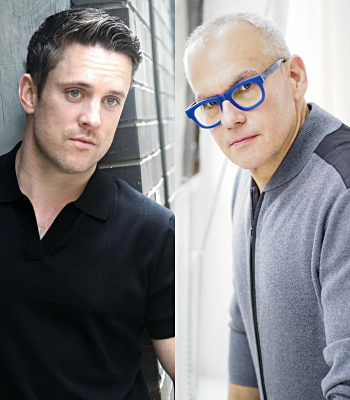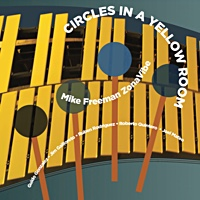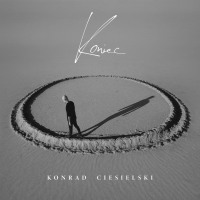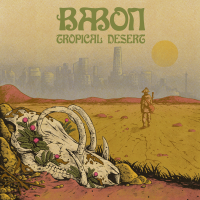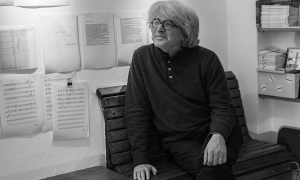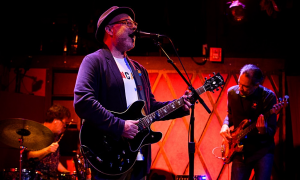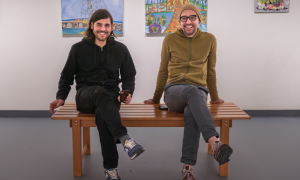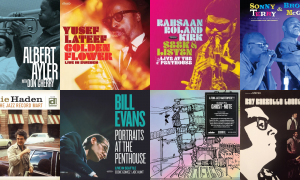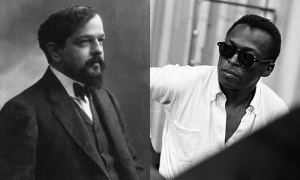Home » Jazz Articles » Interview » Rudy Van Gelder
Rudy Van Gelder

I really want it to sound like that [the original vinyl] because that's what Alfred heard.
For many decades now, the name Rudy Van Gelder has been synonymous with recorded jazz music. The number of sessions he's done over the years easily numbers in the tens of thousands. He's been actively involved in the recording work of such quintessential jazz labels as Prestige, Impulse, Verve, CTI, and of course, Blue Note. In more recent times, Van Gelder has cut sessions for Highnote, Milestone, Reservoir, Venus, and N2K, to name just a few. In fact, drummer T.S. Monk's N2K album, Monk on Monk, was done at Van Gelder's and has received many critical plaudits, most recently being named Jazz Album of the Year in Down Beat Magazine's Annual Readers Poll. From the first time I interviewed Van Gelder in 1989 for a radio program I was producing I could sense his genuine love for the music and his great interest in the legacy he has had a hand in preserving. I found him to be no less engaging and immersed in his work, his new remastering of Blue Note classics in particular, when we had occasion to again speak on the evening of May 26th, 1999.
All About Jazz: For those readers who may not be as familiar with you career, tell me briefly about how you got involved in the recording business.
Rudy Van Gelder: Well, I was always involved in recording when I was a kid. It got to be a business shortly thereafter. I used to record my friends, many of whom were amateur musicians. I used to do it at my parents' house and then people heard about that and then I would get calls from musicians and singers in the neighborhood and they would want me to record them, which I did, making demos and that sort of grew for quite awhile. Then I started getting calls from people in the record business, private record labels at the time, and I started recording for them. That's how I got into it.
The first record I ever made that was sold as a commercial record was one of Joe Mooney, who was an organ player working around here at the time with Bucky Pizzarelli and a bassist by the name of Bob Carter. It was a working trio and I recorded them for this company called Carousel Records and it was actually available for purchase. It was played on the radio and everybody liked it. There was this station in New York, WNEW. The disc jockey was Al Collins and he used to play that every afternoon and so it got to be quite popular.
AAJ: When you started out, how much of the recording equipment was available for purchase and how much did you end up designing and constructing yourself?
RVG: When I first started making records, which was non-commercially, there was nothing available. That was how I got into it, radio and HAM radio, and I used to construct my own equipment. There were no commercial companies making recording consoles as they are today. The major record companies all built their own and if you wanted to do anything you had to do it yourself. Which I did. That's how I started. How much did I end up designing? Of course, it was everything. The only commercial designs were available through radio equipment manufacturers. They had consoles for radio purposes and that was my first console, which was actually a modified radio console. A neat little thing too. It had one meter, but it made some very nice records, some of which I'm remastering right now.
AAJ: Tell us about how you met Alfred Lion and subsequently began to record for Blue Note.
RVG: I had been recording for various independent jazz labels at the time and had never met Alfred and I recorded a band for the musician called Gil Melle. He had a nice little band and came to me through this other label, I think it was Progressive Records. Alfred acquired that record, he bought it and released that on Blue Note as a 10" LP and then he wanted to make another one. At that time, Alfred was going to a studio in New York which was incidentally also a radio studio, WOR studio in New York, and they had a business of making their recording facilities available. So, that's were Alfred went and he took that album to the engineer there and he said, "I want it to sound like this." So the engineer listened to it and told Alfred, "Look, I can't make it sound like that, you better go to the guy who did it." So that's what happened. Alfred came to me and stayed for ever after.
AAJ: You have said that the Rudy Van Gelder "sound" owes a lot to Alfred Lion and the Blue Note legacy. Please explain how Blue Note had an impact on your own development as an engineer.
RVG: In all honesty, I don't want to say that was the whole thing, but he was a large part of it and most of it was his concept of how he wanted his own records to sound and how he approached that and the task which he gave me to make sure that I could get for him what he wanted out of the musicians that he brought in. So, in that way I was subject to this on-going discipline. That formed the foundation of what I did later for different producers and different types of music. Alfred was really the first client who became the foundation of a business for me. Every session he made I recorded for him, so that label got a distinctive sound that way. There was a certain consistency and the people who bought those records would look forward to what was coming next because they knew the record would have a good sound. The musicians were all of a certain caliber and he would get a good performance out of them. So that's all what blended together to launch my adventure in this thing.
AAJ: In a previous interview with me, you discussed how you tried to give each label its own identity soundwise. Without getting too specific or technical, explain how you approached that and how you approached the development of Blue Note's sound.
RVG: I would like to modify something of what you said, you say it's "my sound," really what it is is my feeling and my approach to the musicians I'm recording at a particular session. I really don't like to think of it as being "my sound." What I'm doing really is trying to let the musicians be heard the way they want to be heard. What it really is is the musicians' sound.
Alfred [Lion] would be very meticulous, well-rehearsed, and he would come in and see that everything was going well and he knew what he was going to get before he came into the studio. There were other labels at that time where the producers were much looser and they would just come in and see how things went. And the musicians and the music would very much reflect that. There were two ways of looking at it and that's reflected in the way these records sound. The difference is in the producer. [Alfred] had a feeling for the music and when it was working and when it wasn't working. He was very good at that. He knew when things were working. Now that's not to say that the other producers did not know. It's just that he was the epitome of that kind of producer. He understood what was happening and actually working with him all those years allowed me to understand what is happening and that's one of the things I'm always grateful to him for.
AAJ: How did the invention of stereo effect your approach to recording jazz?
RVG: That was a problem for everyone and not just me. There was no artistic rush to get into stereo from the people I worked for. They had to get into because they had to get into it. As a matter of fact, for quite awhile Alfred and others too had to be making...this is pretty important that you understand this. They had to make two products from the same session. They had to make a mono release in order to have anyone buy it and they had to make a stereo release to make that available to people who were buying stereo. And then of course when the stereo LP came in there was this question of compatibility. Who wants to buy two albums of the same music? You had to make both available and that became very difficult so what happened was everything that was made in Hackensack was mono. Even towards the very end when we were recording two-track we weren't listening in stereo. We were recording in two-track and we were listening in mono because there was only one speaker in Hackensack in the control room and only one speaker in the studio. So how could you listen in stereo when you only have one speaker? And all the judgments, Alfred's judgments, as to mix and balance, and mine too and the musicians too and how they sounded in relationship to each other, and all that during the creative part of those recordings was done in mono. It couldn't be any other way. Towards the end we were running two-track sessions but no one had ever listened to them. So there was no particular attention or attempt at creating a stereo field at that time.
AAJ: Please discuss your approach to the new Rudy Van Gelder Edition Blue Notes in terms of working with the stereo and mono tapes and deciding which format to use for the new master.
RVG: My approach was totally different from what I had heard in the previous CDs. This was first time I had any opportunity to deal with those tapes. Once or twice they sent to me both the mono and stereo versions, which I described to you a minute ago, and the mono would sound much better for obvious reasons, because no one who had been involved in the creation of the original session had ever listened to stereo, but everyone had listened to mono. So I tried to convince them to release the mono version even though it had previously been issued as stereo because I felt that the mono version sounded as if Alfred would have wanted it to be that way. And that is really my goal here. However, there are plenty of albums in this series that are in very good stereo. Until now no one has heard my version of what these early recordings should sound like on CD.
AAJ: Tell us how this whole project came about for remastering the classic Blue Note albums.
RVG: The concept of it came from Hitoshi Namekata. He's the one that runs the Blue Note label in Japan for Toshiba-EMI. He wanted me to do it and he called Michael Cuscuna and Michael called me to see if I was interested and it ended up that absolutely I would be, just as long as I could get the original tapes whenever possible. It had nothing to do with Blue Note New York other than Michael as a producer. Subsequently, there are few issues being made in the United States. They are different. They have extra tracks on them. You see, the concept of this was to duplicate the original LPs as much as possible. They [Japan] didn't want any of the out takes or none of the additional tracks, they wanted it just as it was issued originally. Of course, that made me feel even better.
AAJ: How long have you been engaged in this project?
RVG: I've made a hundred albums on this RVG series in Japan. I've already done this. I've been working on this since 1998 for the whole year of '98 and now I'm doing the second hundred, as opposed to the relatively small amount for the U.S. So you really can't compare the two.
AAJ: Some have said that these new remasters possess a sound that is warmer and much more akin to the original vinyl. How do you feel about that?
RVG: I was so happy to hear you say that because that's my goal. I really want it to sound like that because that's what Alfred heard. No one heard it off a CD. I want people to hear the music with the warmth and the energy and all the things that Alfred and Francis Wolff put into it. I really feel that I'm commissioned to do that. I'm driven by that. That's exactly what I'm trying to do and if someone says that then they understand what I'm trying to do and that's really gratifying.
Photo credit: Mosaic Images
Tags
PREVIOUS / NEXT
Support All About Jazz
 All About Jazz has been a pillar of jazz since 1995, championing it as an art form and, more importantly, supporting the musicians who make it. Our enduring commitment has made "AAJ" one of the most culturally important websites of its kind, read by hundreds of thousands of fans, musicians and industry figures every month.
All About Jazz has been a pillar of jazz since 1995, championing it as an art form and, more importantly, supporting the musicians who make it. Our enduring commitment has made "AAJ" one of the most culturally important websites of its kind, read by hundreds of thousands of fans, musicians and industry figures every month.







